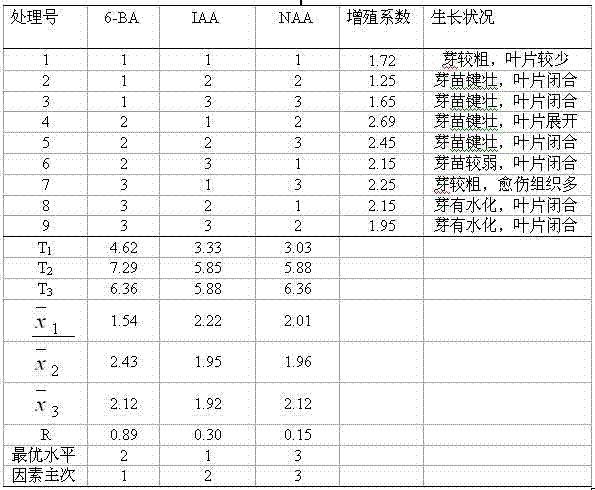Clonal tissue culture breeding method for camphor tree
A technology of clones and camphor trees, which is applied in the field of tissue culture and forest tree tissue culture, can solve the problems of low survival rate of tissue culture seedlings transplanted, long seedling cultivation period, withered brown, etc. The effect of fast propagation of seedlings and reasonable price
- Summary
- Abstract
- Description
- Claims
- Application Information
AI Technical Summary
Problems solved by technology
Method used
Image
Examples
Embodiment 1
[0051] Camphor tree clone tissue culture breeding method, comprises the steps:
[0052] (1) Disinfection of explant materials: remove the leaves from the young shoots of the current year, and cut them into sections so that each section becomes a stem section with 1-2 axillary buds. Wash with water for 6 times, then use 0.1% mercury liter, 2-5 drops of Tween 80, treat for 3 minutes, wash with sterile water for 6 times, sterilize and set aside;
[0053] (2) Bud induction: inoculate the sterilized stem section in step (1) on the bud induction medium for induction culture, after 6-15 days of cultivation, germination begins at the axillary buds, and new shoots grow. The induction medium is DCR 改 +6-BA 0.3mg+NAA 0.05mg;
[0054] (3) Proliferation of buds: After culturing the new shoots grown in step (2) for 30 days, the new shoots are cut off, cultured on the subculture medium, and cultured on the proliferation medium for 6 days, clustered shoots will be formed. Proliferation med...
Embodiment 2
[0059] Camphor tree clone tissue culture breeding method, comprises the steps:
[0060] (1) Disinfection of explant materials: remove the leaves from the young shoots of the current year, and cut them into sections so that each section becomes a stem section with 1-2 axillary buds. The stem sections are first sterilized with 0.2% for 20 minutes, and sterile Wash with water for 6 times, then use 0.1% mercury liter, 2-5 drops of Tween 80, treat for 5 minutes, wash with sterile water for 6 times, sterilize and set aside;
[0061] (2) Bud induction: inoculate the sterilized stem section in step (1) on the bud induction medium for induction culture, after 6-15 days of cultivation, germination begins at the axillary buds, and new shoots grow. The induction medium is DCR 改 +6-BA 0.3mg+NAA 0.5mg;
[0062] (3) Proliferation of buds: After culturing the new shoots grown in step (2) for 30 days, cut off the new shoots, and then culture them on the subculture proliferation medium. After...
Embodiment 3
[0067] Camphor tree clone tissue culture breeding method, comprises the steps:
[0068] (1) Disinfection of explant materials: remove the leaves from the young shoots of the current year, and cut them into sections so that each section becomes a stem section with 1-2 axillary buds. Wash with water for 6 times, then use 0.1% mercury liter, 2-5 drops of Tween 80, treat for 4 minutes, wash with sterile water for 6 times, sterilize and set aside;
[0069] (2) Bud induction: Inoculate the sterilized stem section in step (1) on the bud induction medium for induction culture. After 10 days of cultivation, germination begins at the axillary bud and new buds grow. The induction DCR 改 +6-BA 0.3mg+NAA 0.3mg;
[0070] (3) Proliferation of buds: After culturing the new shoots grown in step (2) for 30 days, the new shoots are cut off, cultured on the subculture medium, and cultured on the proliferation medium for 10 days, clustered shoots will be formed. Proliferation medium for DCR 改 +...
PUM
 Login to View More
Login to View More Abstract
Description
Claims
Application Information
 Login to View More
Login to View More - R&D
- Intellectual Property
- Life Sciences
- Materials
- Tech Scout
- Unparalleled Data Quality
- Higher Quality Content
- 60% Fewer Hallucinations
Browse by: Latest US Patents, China's latest patents, Technical Efficacy Thesaurus, Application Domain, Technology Topic, Popular Technical Reports.
© 2025 PatSnap. All rights reserved.Legal|Privacy policy|Modern Slavery Act Transparency Statement|Sitemap|About US| Contact US: help@patsnap.com



